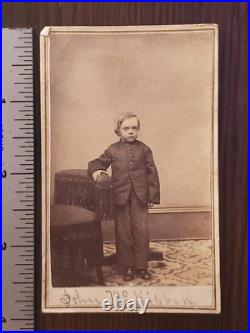
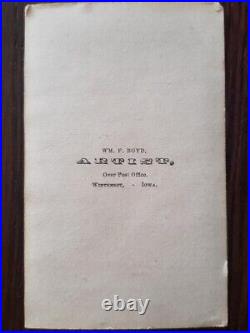
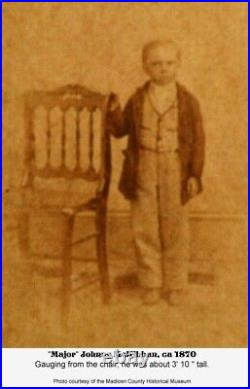
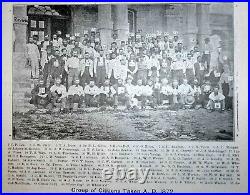

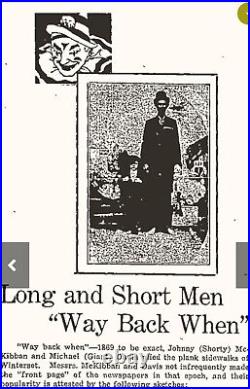
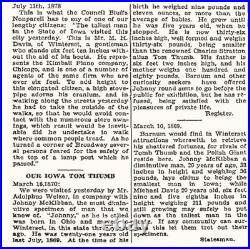

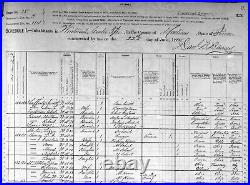
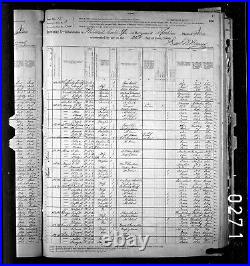

Unpublished, Antique 1865 Civil War CDV Photo ID’d Midget Dwarf Sideshow Freak Madison County Winterset Iowa Identified, hand signed in pencil “John McKibban” (see information below). John “Major Johnny” Mckibban. (July 1849 – September 8, 1880). The physical wonder of Iowa. Is either 15 or 16 years of age in this photo. An article found from 1870, listed below, stated that John McKibban stood thirty-six inches high, and weighed thirty-six pounds, being smaller then the renowned. Another article found from 1870, also listed below, stated that in 1869. Barnum in an attempt to. Retrieve his shattered fortunes. And other curiosity seekers offered Johnny round sums to go before the public for exhibition, but he has refused, desiring to be satisfied. With the pleasures of private life. The photographer is identified as. This item has some wear with corner wear, dings, corner creasing and cdv measures 2 1/2 x 4 inches. Thanks for your interest. Long and Short Men “Way Back When”. “Way back when” – 1869 to be exact, Johnny (Shorty) McKibban and Michael (Giant) Davis plied the plank sidewalks of Winterset. Messrs, McKibban and Davis not infrequently made. The “front page” of the newspapers in that epoch, and their popularity is attested by the. OUR IOWA TOM THUMB. We were visited yesterday by Mr. Adolphus Weiser, in company with Johnny McKibban, the most diminutive specimen of man that we know of. “Johnny” as he is called was born in Ohio and moved to Winterset, in this state three years ago. He was twenty-one tears old last July, 1869. At the time of his birth he weighed nine pounds and eleven ounces, or more than the average of babies. He grew until he was five years old, when he stopped. He is now thirty-six inches high, well formed and weighs thirty-six pounds, being smaller then the renowned Charles Stratton alias Tom Thumb. His father is six feet two inches high, and his mother weighs one hundred and eighty pounds. Barnum and other curiosity seekers have offered Johnny round sums to go before the public for exhibition, but he has refused, being satisfied with the pleasures of private life. Barnum would find in Winterset attractions wherewith to retrieve his shattered fortunes, for rivals of Tom Thumb and the Polish Giant reside here. Johnny McKibban a diminutive man, 20 years of age, 33 inches in height and weighing 36 pounds, lays claims to being the smallest man in Iowa; while Michael Davis 20 years old, six feet nine and five eighths inches in height weighing 211 pounds and still growing may safely be put down as the tallest man in the State. If any community can surpass this let them trot out their specimens. Winterset Madisonian, Thursday, September 16, 1880. Death of Johnny McKibban. This community was greatly surprised last Thursday morning by the sad intelligence of the death of John McKibban, known all over the State as the smallest man in Iowa. He was sick only a few hours and died with inflammation of the stomach. John was born in Pike county, Ohio in the year of 1849 and at birth weighed nine pounds and eleven ounces, which is larger than the average child at birth. He grew as any other children until at the age of five when his growth ceased suddenly and apparently without cause. When it was fully determined he grew no more he was examined by eminent physicians who failed to find any cause for it. Since then he has grown none and at his death was forty two inches high and weighed about 36 pounds. He has always been very healthy, never sick a day or never unable to be out, and John’s face was familiar on the street and will be missed as much as would any one in Winterset. His father and mother moved to Winterset in 1867, where they and he have lived ever since. John has had many lucrative propositions made him to travel on account of his diminutive stature, but not fancying that kind of life and being more of a retiring nature, refused all of them and never engaged in any kind of business except serving as train boy on our railroad, which he followed for some time. He was a great favorite with all who knew him and attracted much notice wherever he went, but he took no delight in making a show of himself and consequently always avoided anything like an inquisitive crowd. We shall sadly miss John’s face and child-like voice as it was his want to hail the people whom he knew on the street, and his joyous laugh was familiar to all. The family have the sympathy of the entire community doubly so as this is the second son they have lost in the past four months. The other, David McKibban, it will be remembered was killed by the cars in Des Moines. Transcriber’s note: Johnny McKibban was often mentioned in the Madisonian throughout the years. He acquired the nickname “Major” and was often referred to as “Major Johnny McKibban” in the newspaper. The origin of that nickname is as yet unknown. Johnny McKibban appears in the front row of the photograph of 1872 citizens found on the Madison County IAGenWeb website. The suddenness of his death is probably due to appendicitis. Daguerreotypes, invented in France by Louis Daguerre in 1839, is a photo image on a silver-plated copper sheet. The highly polished metal surface acts like a mirror, reversing the image which appears or disappears depending on the angle of the light. Typically 2½” x 3¼” in size, the Daguerreotype was covered with glass, set in a bright brass mount and sealed in a hinged wooden case or frame. Daguerreotypes were popular from 1842 to 1856 but were replaced by the less expensive Ambrotypes by 1860. Ambrotypes were created in England in 1851 by Frederick Scott Archer and Peter Fry and later named by Philadelphian Marcus Root. The Ambrotype is a glass plate negative coated with collodian. The plate is backed with black velvet or paint causing the negative to appear as a positive image. Ambrotypes are often confused with Daguerreotypes because they are similar in size, set in a brass mount and sealed in a case or frame under glass. The image, however, is duller and does not have the mirror like surface. Ambrotypes were popular from 1855 to 1861 and waned by 1865. Tintypes, introduced in 1856, were inexpensive photographs with the image processed directly onto a sheet of blackened iron. The reverse image was dark and the surface often blotchy and spotted. The most common size was 2½” x 3½” and often had rough edges from the metal shears used for cutting. While early tintypes were put under glass, later ones were placed in cardboard sleeves. Tintypes were popular because they were strong and could be carried in a pocket, especially during the American Civil War (1860s). Tintypes were popular from 1860 to 1870 but remained as novelty items until 1906. The Carte de Visite were introduced in 1859 by Louis Désiré Blanquart-Evrard, and are known as the first pocket-sized paper photographs. The Carte de Visite translates to visitor card or calling card. CDVs were approximately 2 3/8″ x 4″ and less expensive to produce than the tintype since the image was developed on paper. The paper is coated with egg whites (albumen) and then sensitized with a silver solution. The photograph was then pasted onto a thin card. Since albumen eventually yellows, images took on a sepia hue. CDVs were popular from 1860 to 1880 and generally weren’t used after 1889. Cabinet Cards, introduced in 1864 by a British studio called Windsor & Bridge, were a larger and more refined version of the Carte de Visite. Printed on card stock and typically 4 ½” x 6 ½” in size, they are more durable than other paper types and were frequently displayed in cabinets or bookcases. By the early 1880s Cabinet Cards had nearly replaced all CDVs, and were the dominant portrait format until the end of the century. Cabinet Cards were popular in the US from 1870 to 1900 and rarely seen after 1906.
